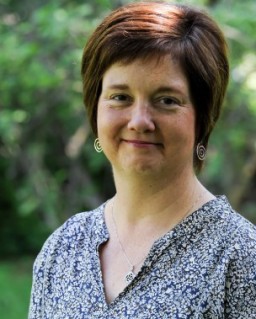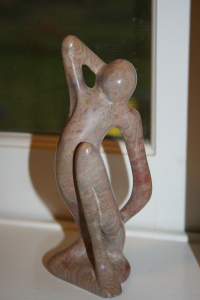
The opening two paragraphs of the recent environment encyclical just might be saying even more than the pope intended. Beginning with a quote from the famous Canticle of the Creatures by St. Francis of Assisi, Laudato Si refers to “our sister, Mother Earth,” and compares the earth to “a sister with whom we share our life and a beautiful mother who opens her arms to embrace us”. Sister and mother are seen here as two separate images. But some translations of the Canticle read “Sister Mother Earth” without commas, consistent with the style of the rest of that text, which names Brother Sun and Sister Moon, etc.
Does a little punctuation difference matter? I think it does.
The single term Sister Mother Earth suggests a seamless linkage between all female bodies, whether our sisters, our mothers, our planet. We are brothers and sisters to one another as Christians (and members of the human family), every person has a biological mother, and the earth sustains us all. “Sister Mother Earth” means there are no distinctions among the three; they are one body. This interpretation lends even greater impact to the second paragraph, where the pope speaks of “this sister who now cries out to us” because of abusive treatment:
“We have come to see ourselves as her lords and masters, entitled to plunder her at will. The violence present in our hearts, wounded by sin, is also reflected in the symptoms of sickness evident in the soil, in the water, in the air and in all forms of life. This is why the earth herself, burdened and laid waste, is among the most abandoned and maltreated of our poor;”
A full understanding of Sister Mother Earth includes women and girls among the most abandoned and maltreated of our poor. Although not mentioned in Laudato Si, like the soil, water and air, the bodies of women and girls also display symptoms of sickness resulting from violence as they too are plundered. Consider that worldwide data indicate up to 50 percent of sexual assaults are committed against girls under 16 and for 30 percent of women, the first sexual experience is forced, a number that increases to 45 percent among those 15 and under at the time it occurs. Women and girls are 80 percent of the estimated 800,000 people trafficked across national borders, with 79 percent trafficked for sexual exploitation. Additionally, global data show that during childbirth women are mistreated through physical, sexual or verbal abuse, stigma and discrimination and the performance of unconsented procedures.
It’s not an exaggeration to say that Sister Mother Earth is assaulted and raped every single day.
 Clearly the pope regards climate change as a serious spiritual matter as the encyclical devotes an entire chapter to this aspect, but given his past statements it’s unsurprising that the implications of a feminine image like Sister Mother Earth are absent from the document. However, hidden in plain sight, a phrase used almost casually in the second paragraph opens a fruitful avenue for exploration. Following the statement about the earth being the most maltreated of our poor, the encyclical quotes Paul’s letter to the Galatians saying that creation “groans” in travail,” a text which refers to giving birth.
Clearly the pope regards climate change as a serious spiritual matter as the encyclical devotes an entire chapter to this aspect, but given his past statements it’s unsurprising that the implications of a feminine image like Sister Mother Earth are absent from the document. However, hidden in plain sight, a phrase used almost casually in the second paragraph opens a fruitful avenue for exploration. Following the statement about the earth being the most maltreated of our poor, the encyclical quotes Paul’s letter to the Galatians saying that creation “groans” in travail,” a text which refers to giving birth.
Creation is indeed groaning, but it’s not because of labor. Creation’s suffering is more like that of cardiovascular disease or cancer. The encyclical’s misuse of this scripture points to a widespread ignorance about the nature of pain in childbirth, a female body process that produces a universal human experience.All of us are born.Clarifying the misunderstanding calls forth new possibilities for an embodied ecological spirituality.
The Christian tradition tends to write off birth pain as God’s punishment for women because of Eve’s sin or to sentimentalize motherhood as beautiful and complementary, but there’s a great deal more to it. In Hebrew, the original language of Genesis, the word that’s translated “punishment” is translated as “work” elsewhere in the bible. The body itself also tells a theological story. Human babies are born with considerable brain growth ahead of them, yet even so their heads are large in proportion to their bodies. In what archeologists call an evolutionary compromise, the female pelvis is just wide enough to accommodate this situation but still narrow enough that women can walk upright. Eating of the tree of knowledge – developing big, intelligent brains – made human birthing painful and risky; it’s a lot of work. While difficult and at times excruciating, this pain is purposeful and healthy.
In a striking passage from the prophet Isaiah related to the Babylonian exile, a traumatic time for the Hebrew people, God actually speaks as a laboring mother: “For a long time I have held my peace, I have kept still and restrained myself; now I will cry out like a woman in labor, I will gasp and pant.” (42:14). This verse contrasts with the more typical preceding image that describes God as a warrior who stirs up his fury, shouts aloud and shows himself mighty against foes.
South African theologian Juliana Claassens sees this unusual juxtaposition as a sign of something new emerging and comments that “ . . . even though both the mother and the warrior are in danger and hence quite vulnerable, both are exceedingly strong. The cries and panting of a woman in labor is not a sign of weakness but of strength; a sign of her determination to ensure that her child enters the world alive and healthy” (p. 56). Claassens calls it “active power in the midst of vulnerability.” In our present peril, we need to wake up and get to work. May the cries of God our birthing mother activate human labors to nurture and protect Sister Mother Earth in all her manifestations.
Peg Conway is the author of Embodying the Sacred: A Spiritual Preparation for Birth and leads programs on birthing spirituality. She blogs at Sense of the Faithful.


“This earth is my sister, I love her daily grace, her silent daring, and how loved I am.” Susan Griffin
LikeLike
Great quote!
LikeLike
Thanks, Peg, for this much needed love for and understanding of our Sister Mother Earth. In an online article at the National Catholic Reporter, Carol Meyer asked the question, “Would Jesus be an environmentalist?” In answer to that, she says:
“Since the church seeks to act in his name under the guidance of his Spirit, I would like to think we are listening to Christ as our church leaders make pronouncements about the urgency of caring for the Earth. […] The whole environmental tragedy is rife with injustices — the rich exploiting the earth for their greed at the expense of the poor and powerless who bear the heaviest load of negative consequences. Jesus would never have sanctioned or been silent about that.”
LikeLike
Glad it found resonance for you.
LikeLike
Thank you for this post, Peg. These images, metaphors, and invitations to new habits of mind and body are our life-line in these times!
LikeLike
That is so true, Marcia!
LikeLike
Nice to see you here, Peg! :)
LikeLike
Thanks, Molly!
LikeLike